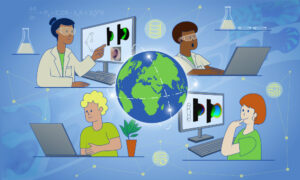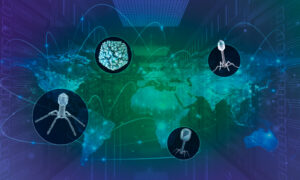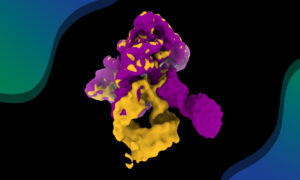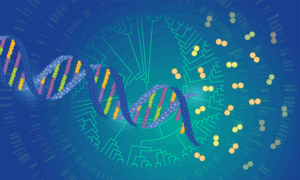
Biology beyond conventional model organisms – a whole new world
Five key takeaways from an EMBL | EMBO Symposium that explored the ‘wild frontiers’ of model organisms, from phytoplankton to sea anemones, waterstriders, roundworms, and more

By Kausthubh Ramachandran, Predoctoral Fellow
Our planet’s environment is rapidly undergoing significant changes. These changes affect our biosphere in every corner of our world, from tiny bacteria to colossal blue whales. Never before in human history has there been a more urgent need to understand living systems and how they interact with each other and the environment.
To achieve this, we would need to go beyond the few well-established ‘model’ organisms scientists currently use. We have thus far relied on these model organisms to ask broad questions in hopes that any insight(s) we gain will be generally true of most other forms of life. There is a growing body of evidence that such extrapolations are on very shaky ground. We therefore need to truly go back to the naturalist tradition of studying diverse life in diverse environments. Luckily, we are now capable of building the tools and expertise needed to examine living systems both on lab benches and in the context of their environment.
To discuss and engage with each other on these questions, biologists of all stripes – from lab experimentalists to theoreticians to field-focused researchers – gathered in the Advanced Training Centre at EMBL Heidelberg in April 2025 for the (hybrid) EMBO | EMBL Symposium ‘Wild frontiers of model organisms’.
As a PhD student studying how proteins evolve, I was, and am, fascinated by life’s complexity and flexibility. For my research, it is absolutely essential to represent this diversity in a balanced manner. This would require me to explore far beyond model organisms, work with scientists from multiple fields, and be familiar with the cutting edge of evolutionary and environmental cell biology. So, this Symposium, with its amazing collection of topics and lineup of speakers, immediately caught my attention.
Here are five key takeaways from the Symposium.
1. Exciting new model organisms in the spotlight
Extensively studied organisms which we can manipulate in a lab setting are called model organisms. We can genetically modify these organisms, observe them in different environments using a variety of tools, and ask questions about how life works. However, the model organisms that we have established and worked with for (in some cases) decades are all concentrated in specific corners of the tree of life. This is an issue because the insights we get from investigating these organisms are usually not generalisable to other parts of the tree of life. That is why several labs are setting up new organisms as models. Here are a few examples.
Lenka Caisova from the Institute of Plant Molecular Biology, Biology Centre CAS, Czech Republic, is setting up Draparnaldia, a type of freshwater green algae, as a new model to study how plants evolved to be able to live on land. Meghan Ferguson from Annika Guse’s group at Ludwig Maximilian University (LMU), Munich, Germany, is studying how corals interact with other organisms and their environment using Aiptasia, an emerging model organism. Jelena Godrijan from the Ruđer Bošković Institute, Croatia, is studying the dynamics of how phytoplankton behave and bloom in our oceans using Calcidiscus leptoporus, a new model coccolithophore – single-celled organisms with a hard calcium-based shell.
2. Symbioses are more the norm than the exception
Symbiosis is a process by which two or more organisms live in close physical contact, to the mutual benefit of all involved. This process plays an incredibly important role in our biosphere. The most widely accepted hypothesis explaining the origin of eukaryotic life (organisms whose cells have a nucleus) is that symbioses between two types of microorganisms – archaea and alphaproteobacteria – gave rise to eukaryotes.
An increasing body of evidence suggests that symbiosis can be observed almost everywhere and at all scales, and it is used to adapt to a changing environment. Ben Jenkins from the Walker Group at University of Cambridge, UK, walked us through how looking at symbiosis in Aiptasia – a type of sea anemone – can help us understand how corals may respond to rising water temperatures. Jean-Baptiste Raina from the University of Technology Sydney, Australia, is looking into how symbionts can recognise each other by studying how certain bacteria can correctly identify their preferred phytoplankton host using special signalling molecules, some of which are curiously evolutionarily close to plant hormones.
Thomas Beavis from EMBL Heidelberg is exploring the wild for symbioses between ciliates (single-celled organisms covered in hair-like cilia) and diatoms, another class of single-celled eukaryotes. What is fascinating about this interaction is that ciliates confer diatoms with the ability to swim, something that they don’t usually do. These investigations both reveal a remarkable flexibility in how life adapts to its environment, and show how difficult, if not impossible, it would be to discover these interactions purely through lab-based studies.
3. Taking the lab to the field
Studying (model) organisms in the lab has gone a long way in improving our understanding of how they behave, how they grow, and how they react to environmental stress. However, a key assumption here is that these organisms would behave the same way in their natural environments. Now, we have the tools and expertise to test this assumption.
One of the largest such tests is being done by the TREC team, an expedition and massive collaboration to study European coastal ecosystems. To aid this, EMBL established a mobile lab facility, including the Advanced Mobile Lab (AML), to bring state-of-the-art molecular biology facilities to the field. Niko Leisch, EMBL’s Head of Mobile Laboratory Services, hunts for symbioses between roundworms and bacteria in the wild. Guy Keren from the Ben-Gurion University of the Negev, Israel, analyses how plant roots interact with nitrogen-fixing bacteria in the field and has found that these interactions could not be observed in the lab. This further emphasises how important it is to study biology in context.
Concurrently, there is a concerted effort to study established model organisms in the contexts of their natural environment. Erik Andersen from Johns Hopkins University is exploring the natural niche of Caenorhabditis elegans, a well-studied model roundworm, and reconstructing what the ancestors of these roundworms and their natural environment would have looked like. Julia Johnke from the University of Kiel is studying how two different model systems, the fruit fly Drosophila melanogaster and C. elegans, behave when they flourish together in the same environment. Kentaro Shimizu at the University of Zurich is using a combination of experimental and field-based approaches to study how the model plant Arabidopsis thaliana behaves in the wild and responds to problems like starvation.
4. How living systems adapt to a changing environment
We live in a warming world with a climate that is undergoing rapid changes. We are already seeing how these rising temperatures are affecting different parts of the biosphere. It is imperative that we study this so that we can respond more effectively to climate change. After all, if we do not understand what we are losing, we cannot hope to engineer solutions to this impending loss. Mantha Lamproussi from EMBL Heidelberg is studying how warming waters affect fish as they develop from egg to adult, using zebrafish as a model. Jonas Brandenburg is carrying out a similar study on sea squirts with Ciona intestinalis as a model. Núria Ros-Rocher is investigating how salinity causes cells to aggregate and become effectively multicellular using the choanoflagellate model Choanoeca flexa. Choanoflagellates are single-celled microorganisms that form colonies under specific conditions and are believed to be the closest unicellular relatives of animals. These approaches tell us that living organisms are far more diverse in their natural niches than we normally assume or give credit for.
5. Interdisciplinary approaches are the need of the moment
Right now, biology is attracting ecologists, chemists, physicists, computer scientists, engineers, and mathematicians to tackle problems using unprecedented, interdisciplinary approaches. This is yielding results that would have been unthinkable even 20 years earlier. Avia Mizrachi from the Weizmann Institute of Science, Israel, brings together live microscopy, microfluidics, flow cytometry, and comparative genomics to study how algal blooms in oceans die out. Lauren Saunders from the Centre for Organismal Studies, Heidelberg University, studies how zebrafish develop from egg to an adult using RNA sequencing, transcriptomics, and clustering approaches. Through the Biodiversity Cell Atlas, this powerful ensemble of tools used to study how zebrafish develop is applied to challenged new models across the tree of life.
Vinca Yadav from the Tomancak Group at MPI-CBG, Germany, is using classical methods from experimental thermodynamics to measure how much energy is used during the development of embryos across animal diversity. None of these could have even been asked or effectively investigated without a confluence of many different methods and scientists.
In conclusion
This young community of scientists who are revolutionising biology both in the lab and the field promises to discover many more secrets of the natural world. EMBL and its many-pronged research programme with its transversal themes, is poised to be at the forefront of this revolution. I am sure this symposium will foster many collaborations and uncover unifying principles explaining key phenomena in biology. I really hope for and look forward to future versions of this event!
The author, Kausthubh Ramachandran, is a Predoctoral Fellow in the Dey Group, EMBL Heidelberg. He attended the EMBO | EMBL Symposium ‘Wild Frontiers of model organisms’ as an event reporter.


